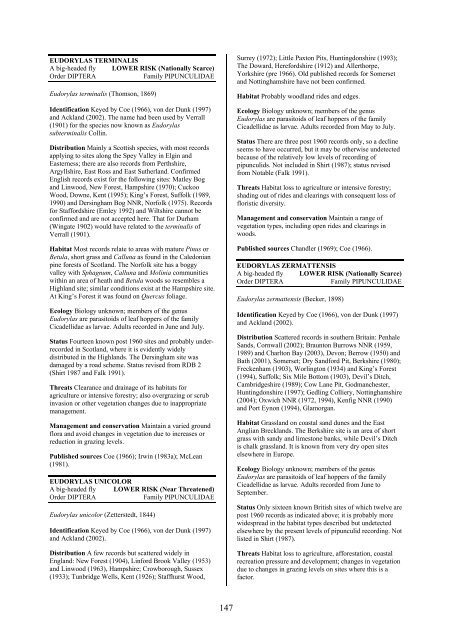Part 2: Nematocera and Aschiza not dealt with by Falk (1991) - JNCC
Part 2: Nematocera and Aschiza not dealt with by Falk (1991) - JNCC
Part 2: Nematocera and Aschiza not dealt with by Falk (1991) - JNCC
Create successful ePaper yourself
Turn your PDF publications into a flip-book with our unique Google optimized e-Paper software.
EUDORYLAS TERMINALIS<br />
A big-headed fly LOWER RISK (Nationally Scarce)<br />
Order DIPTERA<br />
Family PIPUNCULIDAE<br />
Eudorylas terminalis (Thomson, 1869)<br />
Identification Keyed <strong>by</strong> Coe (1966), von der Dunk (1997)<br />
<strong>and</strong> Ackl<strong>and</strong> (2002). The name had been used <strong>by</strong> Verrall<br />
(1901) for the species now known as Eudorylas<br />
subterminalis Collin.<br />
Distribution Mainly a Scottish species, <strong>with</strong> most records<br />
applying to sites along the Spey Valley in Elgin <strong>and</strong><br />
Easterness; there are also records from Perthshire,<br />
Argyllshire, East Ross <strong>and</strong> East Sutherl<strong>and</strong>. Confirmed<br />
English records exist for the following sites: Matley Bog<br />
<strong>and</strong> Linwood, New Forest, Hampshire (1970); Cuckoo<br />
Wood, Downe, Kent (1995); King’s Forest, Suffolk (1989,<br />
1990) <strong>and</strong> Dersingham Bog NNR, Norfolk (1975). Records<br />
for Staffordshire (Emley 1992) <strong>and</strong> Wiltshire can<strong>not</strong> be<br />
confirmed <strong>and</strong> are <strong>not</strong> accepted here. That for Durham<br />
(Wingate 1902) would have related to the terminalis of<br />
Verrall (1901).<br />
Habitat Most records relate to areas <strong>with</strong> mature Pinus or<br />
Betula, short grass <strong>and</strong> Calluna as found in the Caledonian<br />
pine forests of Scotl<strong>and</strong>. The Norfolk site has a boggy<br />
valley <strong>with</strong> Sphagnum, Calluna <strong>and</strong> Molinia communities<br />
<strong>with</strong>in an area of heath <strong>and</strong> Betula woods so resembles a<br />
Highl<strong>and</strong> site; similar conditions exist at the Hampshire site.<br />
At King’s Forest it was found on Quercus foliage.<br />
Ecology Biology unknown; members of the genus<br />
Eudorylas are parasitoids of leaf hoppers of the family<br />
Cicadellidae as larvae. Adults recorded in June <strong>and</strong> July.<br />
Status Fourteen known post 1960 sites <strong>and</strong> probably underrecorded<br />
in Scotl<strong>and</strong>, where it is evidently widely<br />
distributed in the Highl<strong>and</strong>s. The Dersingham site was<br />
damaged <strong>by</strong> a road scheme. Status revised from RDB 2<br />
(Shirt 1987 <strong>and</strong> <strong>Falk</strong> <strong>1991</strong>).<br />
Threats Clearance <strong>and</strong> drainage of its habitats for<br />
agriculture or intensive forestry; also overgrazing or scrub<br />
invasion or other vegetation changes due to inappropriate<br />
management.<br />
Management <strong>and</strong> conservation Maintain a varied ground<br />
flora <strong>and</strong> avoid changes in vegetation due to increases or<br />
reduction in grazing levels.<br />
Published sources Coe (1966); Irwin (1983a); McLean<br />
(1981).<br />
EUDORYLAS UNICOLOR<br />
A big-headed fly LOWER RISK (Near Threatened)<br />
Order DIPTERA<br />
Family PIPUNCULIDAE<br />
Eudorylas unicolor (Zetterstedt, 1844)<br />
Identification Keyed <strong>by</strong> Coe (1966), von der Dunk (1997)<br />
<strong>and</strong> Ackl<strong>and</strong> (2002).<br />
Distribution A few records but scattered widely in<br />
Engl<strong>and</strong>: New Forest (1904), Linford Brook Valley (1953)<br />
<strong>and</strong> Linwood (1963), Hampshire; Crowborough, Sussex<br />
(1933); Tunbridge Wells, Kent (1926); Staffhurst Wood,<br />
Surrey (1972); Little Paxton Pits, Huntingdonshire (1993);<br />
The Doward, Herefordshire (1912) <strong>and</strong> Allerthorpe,<br />
Yorkshire (pre 1966). Old published records for Somerset<br />
<strong>and</strong> Nottinghamshire have <strong>not</strong> been confirmed.<br />
Habitat Probably woodl<strong>and</strong> rides <strong>and</strong> edges.<br />
Ecology Biology unknown; members of the genus<br />
Eudorylas are parasitoids of leaf hoppers of the family<br />
Cicadellidae as larvae. Adults recorded from May to July.<br />
Status There are three post 1960 records only, so a decline<br />
seems to have occurred, but it may be otherwise undetected<br />
because of the relatively low levels of recording of<br />
pipunculids. Not included in Shirt (1987); status revised<br />
from Notable (<strong>Falk</strong> <strong>1991</strong>).<br />
Threats Habitat loss to agriculture or intensive forestry;<br />
shading out of rides <strong>and</strong> clearings <strong>with</strong> consequent loss of<br />
floristic diversity.<br />
Management <strong>and</strong> conservation Maintain a range of<br />
vegetation types, including open rides <strong>and</strong> clearings in<br />
woods.<br />
Published sources Ch<strong>and</strong>ler (1969); Coe (1966).<br />
EUDORYLAS ZERMATTENSIS<br />
A big-headed fly LOWER RISK (Nationally Scarce)<br />
Order DIPTERA<br />
Family PIPUNCULIDAE<br />
Eudorylas zermattensis (Becker, 1898)<br />
Identification Keyed <strong>by</strong> Coe (1966), von der Dunk (1997)<br />
<strong>and</strong> Ackl<strong>and</strong> (2002).<br />
Distribution Scattered records in southern Britain: Penhale<br />
S<strong>and</strong>s, Cornwall (2002); Braunton Burrows NNR (1959,<br />
1989) <strong>and</strong> Charlton Bay (2003), Devon; Berrow (1950) <strong>and</strong><br />
Bath (2001), Somerset; Dry S<strong>and</strong>ford Pit, Berkshire (1980);<br />
Freckenham (1903), Worlington (1934) <strong>and</strong> King’s Forest<br />
(1994), Suffolk; Six Mile Bottom (1903), Devil’s Ditch,<br />
Cambridgeshire (1989); Cow Lane Pit, Godmanchester,<br />
Huntingdonshire (1997); Gedling Colliery, Nottinghamshire<br />
(2004); Oxwich NNR (1972, 1994), Kenfig NNR (1990)<br />
<strong>and</strong> Port Eynon (1994), Glamorgan.<br />
Habitat Grassl<strong>and</strong> on coastal s<strong>and</strong> dunes <strong>and</strong> the East<br />
Anglian Breckl<strong>and</strong>s. The Berkshire site is an area of short<br />
grass <strong>with</strong> s<strong>and</strong>y <strong>and</strong> limestone banks, while Devil’s Ditch<br />
is chalk grassl<strong>and</strong>. It is known from very dry open sites<br />
elsewhere in Europe.<br />
Ecology Biology unknown; members of the genus<br />
Eudorylas are parasitoids of leaf hoppers of the family<br />
Cicadellidae as larvae. Adults recorded from June to<br />
September.<br />
Status Only sixteen known British sites of which twelve are<br />
post 1960 records as indicated above; it is probably more<br />
widespread in the habitat types described but undetected<br />
elsewhere <strong>by</strong> the present levels of pipunculid recording. Not<br />
listed in Shirt (1987).<br />
Threats Habitat loss to agriculture, afforestation, coastal<br />
recreation pressure <strong>and</strong> development; changes in vegetation<br />
due to changes in grazing levels on sites where this is a<br />
factor.<br />
147
















